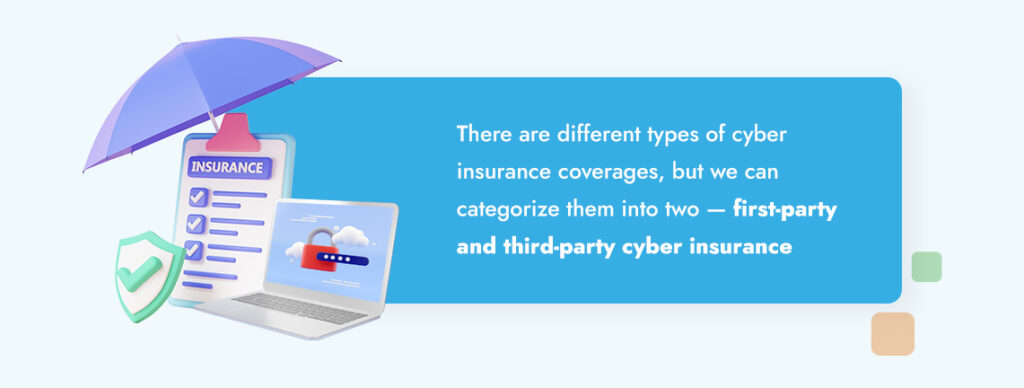
Guide to Cyber Insurance: What Are the Types and What Do They Cover?
A cyber insurance policy is an excellent way to shift risks away from your business. It can help you recover from cyber attacks and continue your operations with less struggle. However, it’s vital to understand what a cyber insurance policy is, how it works and what it covers.
What Is Cyber Insurance?
Cyber insurance protects businesses against financial losses during cyber attacks, like data breaches. The policyholder purchases coverage and pays premiums according to the terms of the agreement. In return, the insurance provider reimburses the business when the covered peril occurs. The coverage may be full or partial, depending on the terms.
For example, Company A, a financial institution, purchases cyber insurance coverage from XYZ Insurance Company worth $400,000. Company A pays its monthly premiums as stipulated in the insurance contract. Unfortunately, Company A’s cyber system was breached, causing them a loss of $340,000. In this case, XYZ Insurance Company may reimburse Company A the total value of the losses. However, if Company A purchased a lesser coverage, they would be responsible for the uncovered portion of the loss.
Cyber insurance is crucial. It helps businesses recover from cyberattacks, which can be devastating in most cases, but especially for smaller companies. Considering over 40% of all data breaches affect small and medium-sized businesses (SMBs), it’s essential to review your cyber insurance policy closely to know the extent of your coverage. You can purchase different types of coverages, each providing a unique protection for your business.

What Are the Types of Cyber Insurance?
There are different types of cyber insurance coverages, but we can categorize them into two — first-party and third-party cyber insurance coverages:
- First-party cyber insurance coverages: The insurance provider pays you directly for the expenses incurred due to the security breach. For example, the insurer may cover the cost if your business loses money because of the cyberattack.
- Third-party cyber insurance coverages: Also known as cyber liability coverage, it caters to expenses you must pay to other persons because they were adversely affected by the cyberattack. Examples include damages arising from lawsuits.
What Does Cyber Insurance Cover?
The nature of protection depends on whether the coverage is first-party or third-party cyber insurance. Let’s dive deeper:
1. First-Party Cyber Insurance Coverage
First-party cyber insurance pays the policyholder for costs, damages and inconveniences arising from a covered incident. Here are six examples:
- Forensic investigation: Forensic investigations help businesses identify the source of cyberattacks and understand the extent of network breaches. The process can be expensive, but insurers can cover the cost if you are insured.
- Theft and fraud coverage: Covers expenses arising from data loss or destruction due to theft or fraud. This includes embezzlement, gift card scams, payroll redirection and first-party cybertheft. The coverage may also apply to risks inherent in electronic funds transfer.
- Cyber extortion and blackmail: Covers expenses incurred in the event of ransomware, a situation where cyber attackers demand monetary payments before granting access to the system or returning stolen data. In such cases, the insurance provider may reimburse you for the losses.
- Business interruption coverage: Covers costs relating to the interruption of business operations due to the cyberattack. Examples include revenue loss due to downtime.
- Data loss and restoration coverage: Protects policyholders who incur costs due to data loss or restorative work. For example, the insurance provider may repair or replace damaged computers or repay the money you spent retrieving the compromised data.
- Media liability coverage: Protects the policyholder against intellectual property infringements. It typically applies to copyright and trademark violations in digital and printed media, including your social media posts.
2. Third-Party Cyber Insurance Coverage
Different types of cyber liability insurance coverages protect businesses against third-party claims or expenses. Here are five examples:
- Credit monitoring: Credit monitoring may be required after a cyber breach to track activities on consumers’ credit reports and alert them of potential issues. This costs money, but insurance providers can incur the expense if you are insured.
- Litigation coverage: Covers legal costs like attorney, filing fees and damages arising from lawsuits. Litigation coverage may also cater to settlement awards, fines and penalties.
- Regulatory coverage: Covers statutory expenses necessary for processing government requests and orders. Typical examples are forensics and preparation of incident reports.
- Emergency response coverage: Some cyber breaches require emergency response, which can cost money. The insurer may pay for those expenses if your insurance policy covers such circumstances, the insurer may pay for those expenses. A good example is the cost of sending emergency notices to the public concerning the breach.
- Breach of privacy and confidentiality: Private and confidentiality breaches can have adverse implications leading to liability. Such a breach can attract civil liability or governmental sanctions. The insurer may cover associated expenses when you purchase coverage against such incidents.
What Does Cyber Insurance Not Cover?
Even the most comprehensive cyber insurance coverage will typically have some exclusions, including the following:
- Poor security systems: Most cyber insurance coverages require businesses to have adequate security protection. Therefore, the insurer may deny claims or refuse to grant a policy if you have inadequate security protocols or configuration management.
- Insider attacks: Cyber insurance coverage may exclude insider attacks, like when an employee breaches the security system.
- Avertible human errors: Most cyber breaches occur due to human errors. However, the business may have to bear the cost where the mistake is unreasonable.
- Prior breaches: Cyber insurance coverages are usually prospective. Events that occurred before the date of purchase of the cyber insurance may not be covered.
- Preexisting vulnerabilities: Businesses are expected to be proactive in their dealings. The insurer may deny your claim if a cyber breach occurs due to failure to correct a preexisting vulnerability.
- System upgrades: Costs of system upgrades are borne by the business. They are not perils and cannot be shifted to insurance providers.
It’s vital to note that these inclusions depend on the facts of the case and are not general. It is essential to review the terms of the coverage and take great care when securing your system. Coverage is typically contingent on the policyholder taking reasonable action to protect their networks. Otherwise, insurers may not offer protection, charge high rates or deny claims when the event happens.

Secure Your Network With Contigo Technology
Insurance payouts are not automatic. There are many instances where insurance claims were denied due to contract breaches or poor IT systems. That being said, securing your network is vital to getting cyber insurance coverage or claim approval. This is where Contigo Technology comes in.
Contigo Technology is a renowned and awared-winning IT managed service provider with years of experience. We assist businesses in Central Texas and beyond with end user support, proactive maintenance and cybersecurity. Contact us now for professional assistance.